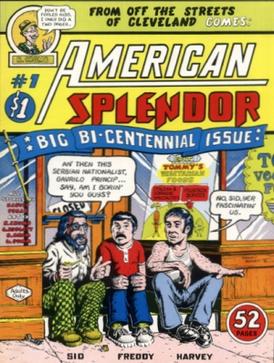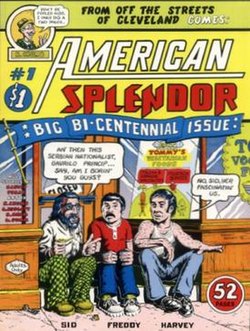Top Qs
Timeline
Chat
Perspective
American Splendor
Autobiographical comic books written by Harvey Pekar From Wikipedia, the free encyclopedia
Remove ads
American Splendor is a series of autobiographical comic books written by Harvey Pekar and drawn by a variety of artists. The first issue was published in 1976 and the last one in September 2008, with publication occurring at irregular intervals. Publishers were, at various times, Harvey Pekar himself, Dark Horse Comics, and DC Comics.[1]
The comics have been adapted into a film of the same name and a number of theatrical productions.
Remove ads
Origins
Summarize
Perspective
Despite comic books in the United States being traditionally the province of fantasy-adventure and other genre stories, Pekar felt that the medium could be put to wider use:
When I was a little kid, and I was reading these comics in the '40s, I kind of got sick of them because after a while, they were just formulaic. I figured there was some kind of a flaw that keeps them from getting better than they are, and then when I saw Robert Crumb's work in the early '60s, when he moved from Philadelphia to Cleveland, and he moved around the corner from me, I thought, 'Man, comics are where it's at'.[2]
Pekar's philosophy of the potential of comics is also expressed in his often repeated statement that "comics are words and pictures. You can do anything with words and pictures".[3] In an interview with Walrus Comix, Pekar described how the idea of producing his own comic book developed. In 1972 when Crumb was visiting him in Cleveland, Pekar showed him his story ideas. Not only did Crumb agree to draw some of them but also offered to show them to other artists to draw. By 1975, Pekar decided to produce and publish his own comic book.[4]
Recurring character Toby Radloff first appeared in American Splendor #9 (1984), as did Joyce Brabner. Pekar and Brabner's adopted daughter, Danielle, was first introduced in American Splendor: Bedtime Stories (1999).
Remove ads
Themes
Summarize
Perspective
The stories in American Splendor concern the everyday life of Pekar in Cleveland, Ohio, told in a brutally frank style akin to the writing of Henry Miller.[5] Pekar's stories eschew traditional narrative structure, focusing on small moments and observations. As Robert Pulcini, co-writer and co-director of the American Splendor film, said: "The whole point of the American Splendor comics is that life doesn't really organize itself well".[6]
Situations covered include Pekar's job as a file clerk at a Veteran's Affairs hospital and his relations with colleagues and patients there. There are also stories about Pekar and his relations with friends and family, including his second wife, Lark (issues #5, #7), his third wife, Joyce Brabner (issue #9 onward), and their adopted daughter, Danielle. Other stories concern everyday situations such as Pekar's troubles with his car, money, his health, and his concerns and anxieties in general.[1] Several issues (#14, #13, #18) give accounts of Pekar's becoming a recurring guest on the NBC television show Late Night with David Letterman, including a 1987 interview segment in which Pekar criticized Letterman for ducking criticism of General Electric, the parent company of NBC. American Splendor sometimes departs from Pekar's own life, with stories about jazz musicians (#23), the artists for his comics (#25), and a three-issue miniseries American Splendor: Unsung Hero (#29–31), which chronicles the Vietnam experience of Pekar's African-American co-worker Robert McNeill.
Remove ads
Artists
Summarize
Perspective
Pekar was not an artist himself, incapable of "drawing a straight line", according to a line in the film version of his story,[7] so he recruited his friend, underground comics artist Robert Crumb, to help launch American Splendor. As Crumb described it:
"...[H]e didn't draw at all. He never even tried to learn. But he understood comics very well, and the rhythm of comics.... He was deeply into comics so he had a feel for how to tell a story in comic book form.... He was a great comic book writer".[8]
As The Complete Crumb Comics co-editor Robert Fiore wrote about the Pekar/Crumb collaborations:
[I]n American Splendor, Crumb's work stood out for ... the way he really made Pekar's voice SING. His style embodied Pekar's voice.... He turned Pekar's scripts into pure comics, into something that would have been inferior in any other medium.... But I think what makes all of their collaborations work so well is the fact that Crumb is as sympathetic a collaborator as Pekar ever had. It's not just the fact that Crumb draws better than everybody else, he knew what to draw. Just as Pekar knew what to write.... Their mutual understanding of each other helped me appreciate each as artists and voices....[9]
As things evolved, however, Crumb explained:
"I didn't want to spend all of my time just drawing [Pekar's] stuff. So, he very quickly realized that and got other artists to draw his stuff too. He chased down all kinds of artists to draw his comics".[8]
In addition to Crumb, Pekar's most well-known and longest-running collaborators included Gary Dumm, Greg Budgett, Spain Rodriguez, Joe Zabel, Gerry Shamray, Frank Stack, Mark Zingarelli, and Joe Sacco. Other notable American Splendor illustrators include Alison Bechdel, Joyce Brabner, Brian Bram, Chester Brown, Alan Moore, David Collier, Drew Friedman, Michael T. Gilbert, Dean Haspiel, Paul Mavrides, Val Mayerik, Josh Neufeld, Ed Piskor, James Sherman, Don Simpson and Jim Woodring. The later Vertigo Comics-published issues employed a new crop of artists, including Ty Templeton, Richard Corben, Hunt Emerson, Eddie Campbell, Gilbert Hernandez, Ho Che Anderson, Hilary Barta, Bob Fingerman, Rick Geary, David Lapham, John Lucas, Leonardo Manco, José Marzan Jr., Warren Pleece, Chris Samnee and Chris Weston.
Remove ads
Publication history
Summarize
Perspective
Pekar produced seventeen issues of American Splendor from 1976 to 1993 — usually each May[10] — which, except for the last few issues, he also self-published and self-distributed. By keeping back issues in print and available (contrary to the industry practice of the time), Pekar continued to receive income on previously completed work, although at the time some of them were published, according to his Comics Journal interview (1985), he was losing thousands of dollars per year on the books. [11]Starting in 1994, additional American Splendor were published by Dark Horse Comics, although these issues are not numbered. They include the two-issue American Splendor: Windfall and several themed issues such as American Splendor: Transatlantic Comics and American Splendor: On the Job. In September 2006, a four-issue American Splendor mini-series was published by the DC Comics imprint Vertigo. A second four-issue miniseries was published by DC in 2008.
Remove ads
Collected editions
Many stories from American Splendor have been collected into trade paperbacks from various publishers, their material not (for the most part) overlapping:
- American Splendor: The Life and Times of Harvey Pekar (Doubleday, 1986) ISBN 0-345-46830-9
- More American Splendor (Doubleday, 1987) ISBN 0-385-24073-2
- The New American Splendor Anthology (Four Walls Eight Windows, 1991) ISBN 0-941423-64-6
- American Splendor Presents: Bob & Harv's Comics, with R. Crumb (Four Walls Eight Windows, 1996) ISBN 1-56858-101-7
- American Splendor: Unsung Hero, with David Collier (Dark Horse Comics, 2003) ISBN 1-59307-040-3
- Best of American Splendor (Ballantine Books, 2005) ISBN 0-345-47938-6
- American Splendor: Another Day (DC/Vertigo, 2007) ISBN 978-1-4012-1235-3
- American Splendor: Another Dollar (DC/Vertigo, 2009)
Remove ads
Graphic novels and other collections
Summarize
Perspective
Pekar wrote two larger works that carry the American Splendor label: Our Movie Year (Ballantine Books, 2004) and Ego & Hubris: The Michael Malice Story (Ballantine, 2006). Our Movie Year is a collection of comics written about or at the time of the American Splendor film; it includes an original piece illustrated by Ed Piskor, as well as material originally published in a variety of sources, including Entertainment Weekly, Cleveland Scene, The New York Times, Time Out New York, LA Weekly, Empire magazine, Gambit Weekly, the Music Maker Relief Foundation, the American Splendor film soundtrack CD, and the Sundance Film Festival Daily Insider.[12] Ego & Hubris is a biography of the early life of the author Michael Malice.
Pekar also wrote two graphic novels which are not officially labeled American Splendor but which should arguably be considered part of it: Our Cancer Year (Four Walls Eight Windows, 1994), co-written with Pekar's wife Joyce Brabner and illustrated by Frank Stack, covering the year when Pekar was diagnosed with cancer; and The Quitter (DC/Vertigo, 2005), illustrated by Dean Haspiel, which deals with Pekar's youth.
- Harvey Pekar and Joyce Brabner (w), Frank Stack (a). Our Cancer Year (1994). Four Walls Eight Windows. ISBN 1-56858-011-8
- Harvey Pekar (w), various (a). American Splendor: Our Movie Year (2004). Ballantine Books. ISBN 0-345-47937-8
- Harvey Pekar (w), Dean Haspiel (a). The Quitter (2005). DC/Vertigo. ISBN 1-4012-0399-X
- Harvey Pekar (w), Gary Dumm (a). American Splendor Presents: Ego & Hubris - The Michael Malice Story (2006). Ballantine Books. ISBN 0-345-47939-4
Remove ads
Adaptations
Summarize
Perspective
Theatrical productions
Theatrical productions based on American Splendor have been mounted over the years:
- September–October 1985[13] – Adapted and directed by Conrad Bishop, with Herb O'Dell as Harvey. Produced by The Independent Eye in Lancaster, Pennsylvania.
- November 1987 – Adapted by Lloyd Rose and directed by James C. Nicola,[14] with Richard Bauer as Harvey, Isiah Whitlock Jr. as Mr. Boats, and Brigid Cleary and Anderson Matthews in supporting roles. Produced by Arena Stage in the Old Vat Room in Washington, DC.[15]
- September 1990–September 1991 – Adapted and directed by Vince Waldron, with Dan Castellaneta as Harvey, Andy Wilson as Mr. Boats, and Richard Kuhlman, Steve Sheridan, Monica Horan, David O'Shea, and Siobhan Fallon Hogan in supporting roles. Produced at the Theatre/Theater in Hollywood, California[14] (and represented in fictionalized form in the American Splendor film, with Donal Logue as Harvey and Molly Shannon as Joyce).
- 2024-2025 – Composed by Scott Fields, Pekar is a musical suite of stories from American Splendor comic books. The 95-minute-long suite includes eight stories, with instrumental interludes. The instrumentation is female voice, accordion, marimba, guitar, and tuba. Pages from the corresponding comics are projected as surtitles.[16] The premiere of Pekar was held on November 14, 2024, in Cologne, Germany, with performances in nine other German cities in 2025.[citation needed] Development of the suite was started with Joyce Brabner in 2021.[citation needed]
Film
In 2003 a film adaptation featuring Paul Giamatti playing Pekar (as well as appearances by Pekar himself) and Hope Davis as his wife was released to critical acclaim and first honors at the Sundance Film Festival,[17] in addition to the Writers Guild of America Award for best adapted screenplay.[18] The film was written and directed by documentarians Shari Springer Berman and Robert Pulcini, and was filmed entirely on location in Cleveland and Lakewood in Ohio. At the 2003 Cannes Film Festival, the film received the FIPRESCI critics award.[19] It was also nominated for Best Adapted Screenplay at the 2003 Academy Awards.[20]
Remove ads
Further reading
- Fiene, Donald M. (April 1985). "From Off the Streets of Cleveland: The Life and Work of Harvey Pekar". The Comics Journal. No. 97. pp. 65–70.
References
Sources
External links
Wikiwand - on
Seamless Wikipedia browsing. On steroids.
Remove ads

